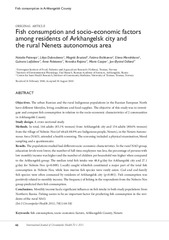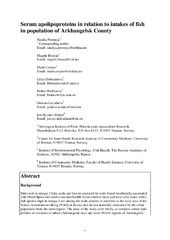| dc.contributor.advisor | Odland, Jon Øyvind | |
| dc.contributor.author | Petrenya, Natalia | |
| dc.date.accessioned | 2013-01-21T12:19:43Z | |
| dc.date.available | 2013-01-21T12:19:43Z | |
| dc.date.issued | 2012-12-14 | |
| dc.description.abstract | Russia is a country with a high level of cardiovascular diseases (CVD) death. The nation has
experienced several economic crises after the dissolution of the Soviet Union in 1991. While
CVD-related deaths have decreased in Japan, North America and Western Europe during recent decades, CVD deaths in Russia have increased. Fish consumption is believed to have cardio-protective effects. Fish consumption in the Russian Federation dropped dramatically during the period of post Soviet reforms.
According to Russian Federal State Statistics Service, in 1994-2000 it was approximately 9-10 kg per capita per year, which was half that of Soviet times. In 2010, fish and fish product consumption was reported to be 15.5 kg per capita per year. Epidemiological studies where diet is the central focus are scanty in the Russian Federation. Lean reindeer meet and local cold water whitefish species high in omega-3 fatty acids are among the main sources of nutrients in the rural area of the Nenets Autonomous Area⁄Okrug (NAO) and are not normally consumed by the urban Arkhangelsk population in Arkhangelsk County. The traditional diet high in omega-3 fatty acids has been shown to be favorably related to blood lipid profiles.
The unique indigenous circumpolar population Nenets is among the rural NAO inhabitants. Economical crises and transition to western lifestyle are believed to negatively affect the health of the native circumpolar population of the Russian Arctic, however little
information on health and prevalence of chronic diseases and their risk factors is available. On the contrary, plenty of large studies on health conditions of native Arctic people in Canada, Greenland, US and scandinavian contries have been performed.
The objectives of this PhD thesis were to contribute to the knowledge about health conditions of the circumpolar population of the rural NAO in comparison with the urban population of Arkhangelsk County with focus on risk factors for CVD; to estimate fish intake
in these populations and to study the relationship between fish intake and blood apolipoprotein profile. We have additionally studied the prevalence and pattern of obesity in women.
The results of the thesis suggest that fish intake in Arkhangelsk County is comparable to the level officially reported for the Russian Federation. However, the rural NAO residents have experienced an increasingly impaired availability of local whitefish species, which has resulted in reduced consumption compared to the Soviet Union period, at least in some
communities. A great prevalence of smokers among men and a high proportion of obese women were detected in both locations. We did not find any differences in apolipoprotein B⁄apolipoprotein A-I ratio in either men or women, when communities were compared, however, relatively favourable lipid profiles were seen in the NAO group. This could be at least partially explained by higher physical activity in men and lower intake of saturated fat from meat dishes in women from the rural NAO group. The findings also suggest that despite
lower level of cardiometabolic risk markers among normal weight women from NAO compared to their urban Arkhangelsk counterparts, diabetes and CVD are likely to increase in this female indigenous population due to high prevalence of central obesity known to be
associated with cardiometabolic risk. Low levels of high-density lipoprotein cholesterol, high blood pressure and greater waist circumference were the major components of metabolic syndrome in women from both locations. Fish consumption was not associated with dyslipidemia in our study. In addition, our survey provides evidence of alcohol-related problems in the Arctic population of Russia which should be further investigated.
The main conclusion from this work is that a traditional and nutritionally important component of the diet i.e. fish intake is decreasing in the rural NAO population. Low monthly income was found to be a socio-economic indicator of low fish consumption. To maintain the fishing activities and increase availability of valuable fish species is important for the rural NAO group. Lifestyle, leading to obesity, low physical activity, high consumption of foods
rich in starch, sugar and saturated fat, smoking, hazardous alcohol consumption and hypertension are the modifiable risk factors and should be targeted to prevent further increases in incidence of CVD and diabetes. More detailed analysis of dietary habits is
needed. Large representative cross-sectional studies and prospective cohort studies are also required. | en |
| dc.description.doctoraltype | ph.d. | en |
| dc.description.popularabstract | Norske hovedfunn i avhandlingen:
Endrede matvaner med lite fisk og dårlig levekår blant Nenets befolkning I NordVest Russland. Denne doktorgradsstudien ved UiT viser farlige trender i livsstil endringer med lite fisk i kosten, fedme, røyking og alkohol misbruk blant Nenets befolkning i NordVest Russland.
English short summary:
This study was a collaboration project between Norway and Russia undertaken to elucidate fish consumption pattern in relation to the prevalence of cardiometabolic risk factors in the North-West Russia.
Russia is a country with a high level of cardiovascular diseases (CVD). High fish consumption was suggested as a factor behind low CVD mortality in some circumpolar populations in the West.
The objective of the thesis was to study diet, lifestyle and CVD risk factors in the rural Nenets Autonomus Okrug∕Area (NAO) in comparison with urban population of Arkhangelsk County.
The study demonstrated that in 2008 fish consumption in the rural NAO was unexpectedly low, especially when compared to the level of Soviet time. High prevalence of smoking in men and obesity in women were detected both in NAO and in the urban population of Arkhangelsk. No differences were detected in apolipoprotein B∕apolipoprotein A-I ratio between the two communities, however, relatively favorable lipid profiles were seen in the Nenets. This could be explained by higher physical activity in men and lower intake of saturated fat from meat dishes in women. Despite the better lipid profile, diabetes and CVD are still likely to increase in this indigenous population due to high prevalence of central obesity. Fish consumption was not associated with dyslipidemia in our study. In addition, our survey provides evidence of alcohol-related problems in the Arctic population of Russia which should be further investigated.
The main conclusion from this work is that a traditional and nutritionally important component of the diet - fish intake is decreasing in the rural NAO population. Low monthly income was found to be a socio-economic indicator of low fish consumption. Lifestyle should be targeted to prevent further increases in incidence of CVD and diabetes. | en |
| dc.description.sponsorship | Nofima og Institutt for Samfunnsmedisin, UiT | en |
| dc.description | Paper 3 of this thesis is not available in Munin: <br/>3. Natalia Petrenya, Liliya Dobrodeeva, Magritt Brustad, Fatima Bichkaeva, Gulnara Lutfalieva, Marie Cooper and Jon Øyvind Odland: 'General and central obesity and obesity-associated cardiometbolic risk in women from the rural Nenets Autonomous Area compared to Russian
urban counterparts' (manuscript) | en |
| dc.identifier.uri | https://hdl.handle.net/10037/4787 | |
| dc.identifier.urn | URN:NBN:no-uit_munin_4500 | |
| dc.language.iso | eng | en |
| dc.publisher | University of Tromsø | en |
| dc.publisher | Universitetet i Tromsø | en |
| dc.relation.ispartofseries | ISM skriftserie, nr 131 | |
| dc.rights.accessRights | openAccess | |
| dc.rights.holder | Copyright 2012 The Author(s) | |
| dc.rights.uri | https://creativecommons.org/licenses/by-nc-sa/3.0 | en_US |
| dc.rights | Attribution-NonCommercial-ShareAlike 3.0 Unported (CC BY-NC-SA 3.0) | en_US |
| dc.subject | VDP::Medical disciplines: 700 | en |
| dc.subject | VDP::Medisinske Fag: 700 | en |
| dc.title | A study of fish consumption and cardiometabolic risk factors among the circumpolar population of the rural Nenets Autonomous Area in comparison with the urban population of Arkhangelsk County | en |
| dc.type | Doctoral thesis | en |
| dc.type | Doktorgradsavhandling | en |


 English
English norsk
norsk


